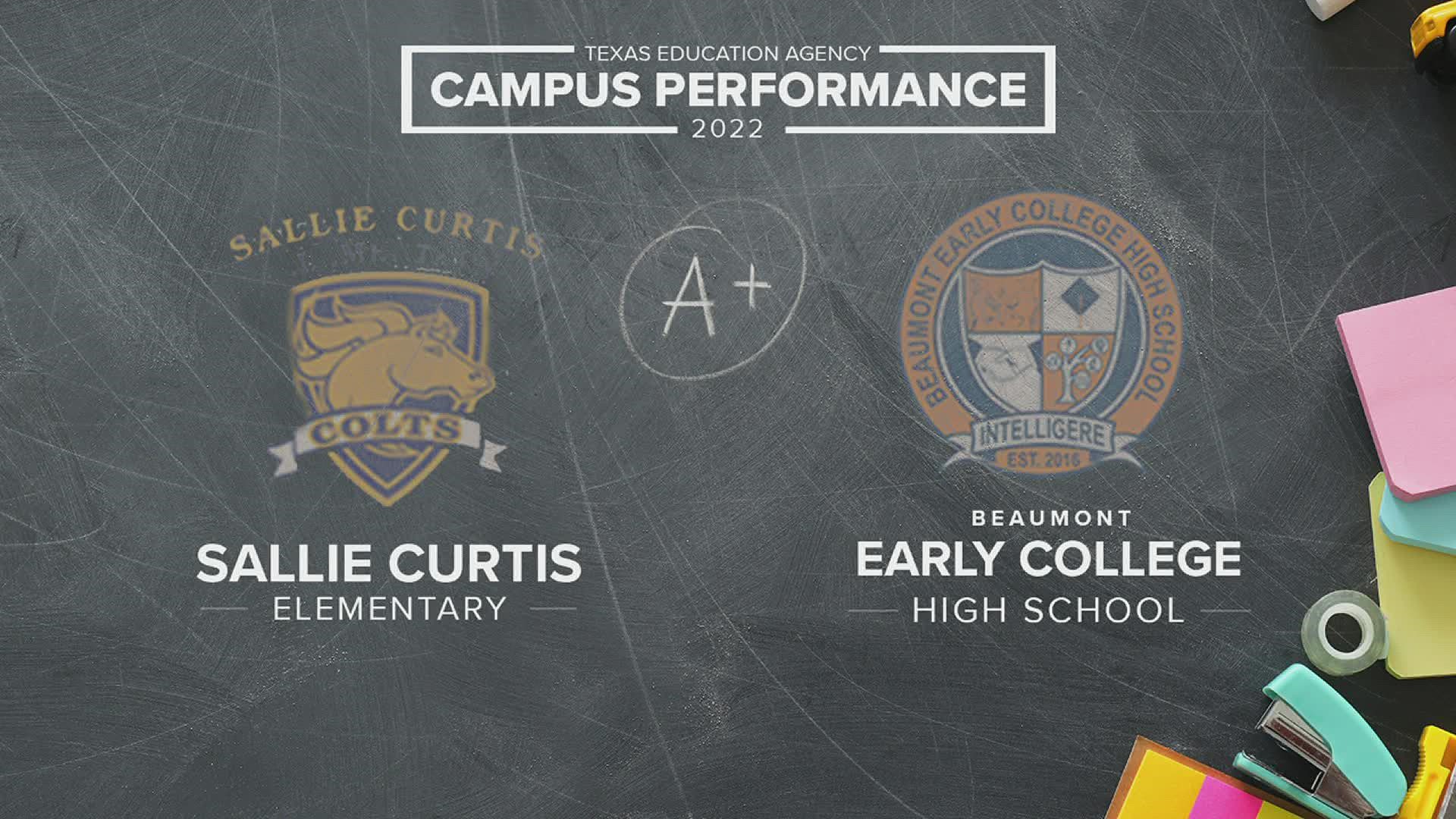BEAUMONT, Texas — Two Beaumont Independent School District campuses and two Beaumont charter schools received A grades from the TEA for 2022 but 14 BISD campuses were not rated.
The Texas Education Agency released its accountability ratings for the state’s school districts and individual campuses on Monday morning.
(EDITOR'S NOTE: The video above first aired on July 22, 2022.)
Sallie Curtis Elementary and the Beaumont ISD Early College campus received As as did Harmony Science Academy and Evolution Academy.
Fourteen BISD campuses, including both high schools and four of five middle schools were not rated for 2022. In 2019, the last year that schools were rated before the pandemic, eight Beaumont ISD campuses received a failing grade.
Seven Beaumont ISD campuses received Bs including six elementary and a middle school according to the TEA data released Monday morning.
Three elementary campuses received Cs and the district as a whole did not receive a rating.
The TEA is not providing grade ratings for 2022 to schools that received less than a C.
TEA Commissioner Mike Morath said those grades won’t count this year, per Senate Bill 1365, which gives a 'not rated' score to campuses or districts that received scores lower than 70.
“This year, we will be providing A, B and C ratings for all of our campuses, but we will not necessarily subject our campuses to interventions. They do not formally receive a D or an F label because we want to make sure the system has time to recover,” Morath said. “Expectations do always matter. We have to make sure we are setting reasonable goals and making adjustments given the conditions that we see.”
Here's how Beaumont ISD schools measured up...
- Beaumont ISD Early College HS - A
- Curtis Elem - A
- Amelia Elem - B
- Blanchette Elem - B
- Charlton-Pollard Elem - B
- Guess Elem - B
- Martin Elem - B
- Odom MS - B
- Regina Howell Elem - B
- Caldwood Elem - C
- Dishman Elem - C
- Homer Dr Elem - C
- Beaumont New El DEAP - Not Rated
- Beaumont United HS - Not Rated
- Bingman PK - Not Rated
- Dr Mae E Jones-Clark Elem - Not Rated
- Fehl-Price Elem - Not Rated
- Lucas PK - Not Rated
- M L King MS - Not Rated
- Marshall MS - Not Rated
- Pathways Learning Ctr - Not Rated
- Paul A Brown Alternative Center - Not Rated
- Pietzsch/Mac Arthur Elem - Not Rated
- Smith MS - Not Rated
- Vincent MS - Not Rated
- West Brook Sr HS - Not Rated
This is the first time since the COVID pandemic began that the TEA has rated schools and, according to the TEA, it shows progress in catching students up.
The TEA released A through F ratings for 1,195 school districts and 8,451 campuses across the state. According to the accountability report, in 2022, 25% of districts and 33% of school campuses increased in letter grades from where they were in 2019.
Forty-two districts and 564 campuses in the state received this 'not rated' label.
How the scores are calculated
The overall score is measured through three different measurements -- student achievement, school progress, which includes academic growth and relative performance, and 'closing the gap.'
Achievement
For elementary school students, achievement is 100% calculated through the STAAR test. That’s the same for middle schools. In high school, the STAAR accounts for 40% of student achievement, with another 40% from college, career or military readiness and 20% on graduation rates.
School progress
Student academic growth and relative performance also weigh in. Relative performance takes into account poverty levels and performance. Morath was quick to point out that ‘poverty does not equal destiny.’
“Eighteen percent of all high-poverty campuses in Texas scored 90 or above,” Morath said.
High poverty schools are those where 80% or more of students are eligible for free or reduced lunch.
As for academic growth, it measures how students perform from grade level to grade level and if they're achieving goals set at each grade level.
Closing the gap
Finally, the TEA has a measurement called ‘closing the gap,’ in which students are broken down by groups, specifically by ethnicity, special education, students who are continually enrolled or mobile, English learners and those who are economically disadvantaged.
“We set goals and evaluate how well those goals are being achieved in each of those groups to ensure we are, in fact, closing the gaps, that every child is being well-served in our schools,” Morath said.
Final score
Individual school campuses and districts are given A through F ratings in student achievement, school progress and closing the gap. Then the overall rating for the campus or district is calculated. The TEA takes the best of the student achievement or school progress to make up 70% of the grade and then 30% is from ‘closing the gap.’
“This gives schools many ways to show their excellence, recognizes the diversity of schools and honors our obligation. We value student achievement, the proficiency in getting kids to high level of achievement,” Morath said.
GET NEWS & WEATHER ALERTS | Download the 12News App to your mobile device

